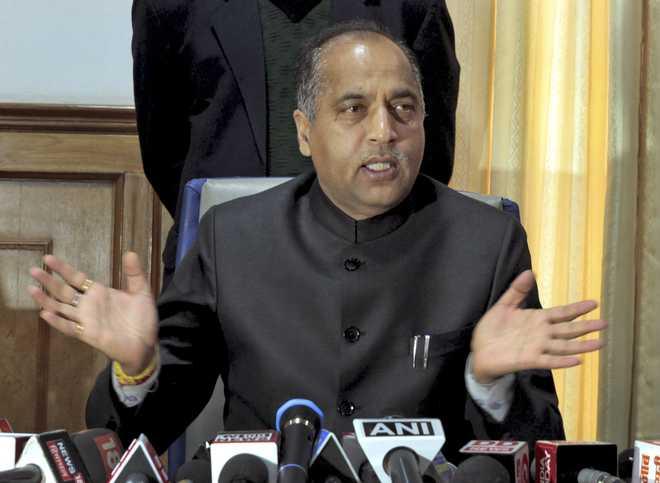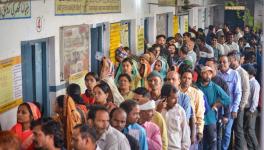HP Assembly Elections: Will Voters Show BJP the Door?

Image credit: Tribune India
Shimla: The Election Commission (EC) on October 14 announced that the Himachal Pradesh Assembly election would be held on November 12 and votes would be counted on December 8, while the schedule for the other poll-bound state, Gujarat, was not announced.
Last time around, the EC had also announced the schedules of the two states separately, Himachal Pradesh on October 12, 2017, and Gujarat on October 25, 2017. However, the counting of votes in both states was on the same day in December.
The small hill state is spread over 55,673 square kilometres, with 12 districts in the state and 68 Assembly constituencies. Out of the 68 constituencies, 17 are reserved for Scheduled Castes (SCs) and three are reserved for Scheduled Tribes (STs).
A total of 55,74,793 electors, including 1.86 lakh first-time voters and 1.22 lakh electors over the age of 80, will be eligible to cast their votes, out of which 55,07,261 are general voters and 67,532 are Service voters.
Nominations
As per the EC schedule, the nomination process for the 68-seat Himachal Pradesh Assembly election began with the gazette notification on October 17 and the last date for filing nominations was October 25. As many as 550 candidates have filed their nominations.
The state, currently ruled by the Bharatiya Janata Party (BJP), has seen bipolar elections in the past three decades, dominated by the BJP and Congress. The BJP won 44 seats in the previous Assembly polls in 2017 while Congress won 21 seats with the Communist Party of India (Marxist) [CPI(M)] also securing a seat. Whereas, Congress won 36 seats in 2012 and formed the government as the BJP secured 26 seats.
The BJP and Congress have announced candidature for all 68 seats this year. Arvind Kejriwal’s Aam Aadmi Party (AAP), after its victory in neighbouring Punjab in March, has set its sights on Himachal Pradesh by announcing a total of 58 candidates. The CPI(M) has announced its candidates for 11 seats and has decided to support the AAP in the remaining seats.
Bereft of a strong cadre base and popular face, the AAP has relied on promising “freebies” and Kejriwal’s charisma. However, the party’s campaign seems to have gone off-track lately, as the AAP leaders seem to have turned their focus to Gujarat.
It’s not the first time that the AAP is trying its luck in Himachal Pradesh. The party contested the 2014 Lok Sabha elections in the state, but the performance of its candidates, former BJP MP Rajan Sushant and Kamal Kanta Batra, the mother of Kargil martyr Capt Vikram Batra among them, was dismal. The party stayed away from the state during the 2017 Assembly and 2019 Lok Sabha elections.
Ticket Allocation
The hill state is set for a fierce electoral battle between the BJP and Congress. However, both dominating parties are facing rebels who can upset the apple cart in over 15 of the 68 Assembly constituencies.
A total of 413 candidates have been left in the fray after 92 candidates withdrew their nomination papers on October 29. As many as 45 nominations were rejected. Leaders of both political parties were on their toes to persuade the rebels to withdraw their nomination in the “larger interest” of the parties.
The BJP has managed to convince former Member of Parliament (MP) Maheshwar Singh to withdraw as an Independent. Singh had filed his nomination after the BJP changed its candidate at the last minute. The saffron party’s change of stance can be attributed to the candidature of Hiteshwar Singh—Maheshwar Singh’s son—who will be contesting independently from Banjar against BJP’s sitting MLA Surinder Shourie. Maheshwar Singh could have caused trouble for the party in the Kullu (Sadar) and Banjar Assembly seats. Meanwhile, the Congress has persuaded former minister Kuldeep Kumar from Chintpurni and MLAs Biru Ram Kishore (Jhandutta) and Tilak Raj (Bilaspur) to withdraw their nominations.
The Congress rebels contesting the elections include former minister Gangu Ram Musafir from Pachhad, former MLA Subhash Manglet from Chopal, and former MLA Jagjivan Pal from Sullah.
The BJP could face damage from ex-MP Kripal Parmar contesting the Fatehpur seat, former MLA from Dharamsala Vipin Nehria, former MLA from Kinnaur Tejwant Negi, and Hoshiyar Singh, who won the 2017 Assembly poll as an Independent from Dehra and then had joined the BJP. He was also denied the ticket and is contesting as an Independent.
Other BJP rebels include Manohar Dhiman from Indora, Ram Singh from Kullu, Hiteshwar Singh from Banjar, Indira Kapoor from Chamba and Praveen Sharma from Mandi, while other Congress rebels include Vijay Pal Khachi and Indu Verma from Theog, Sanjeev Bhandari from Jogindernagar, and Paras Ram from Anni.
There is a three-way contest in three constituencies – Lahaul and Spiti, Darang, and Churah – while a multi-corner contest will be witnessed for the remaining seats.
Cong, BJP, and Infighting
The electioneering for the Congress party, which is fighting to wrest power from the BJP, has been largely steered by the state leadership – barring a maiden rally by Congress general secretary Priyanka Gandhi Vadra last week in Solan district. The Congress is banking on the ‘anti-incumbency’ factor against the BJP, but the going has not been smooth.
Several political commentators believe that in the absence of its tallest leader and six-time CM, the late Virbhadra Singh, there seems to be a ‘vacuum’ in the state leadership.
Even though his wife Pratibha Singh was given the reins of the party in the state, the appeal and political acumen of the former chief minister seem difficult to replace. Due to the lack of strong leadership, factionalism has been coming to the fore time and again, which has led to several senior leaders including sitting MLAs quitting party posts. The problem of there being several claimants for the post of chief minister is another grave concern.
A current government employee, on the condition of anonymity, told NewsClick, “The BJP government has always made policies that are not in favour of the employees. OPS is the main issue haunting the BJP’s mission repeat.”
They added, “The anti-incumbency sentiment is very strong; in fact, the CM has not proved to be a strong statesman. This is also a key factor riding against the BJP.”
With a not-so-popular CM, Jai Ram Thakur (chosen again as the CM face by the BJP in 2022), strong anti-incumbency and the BJP rebels refusing to quit in several constituencies, the BJP also has its work cut out.
“As it stands, it will be very tough for the BJP to come to power again though the margin of victory might be less and the competition is close. This is only due to the weak opposition. If Mr Virbhadra Singh were alive, a lot of sitting MLAs from the BJP stood to lose their securities,” another government employee told NewsClick on the condition of anonymity.
OPS: A Key Poll Plank
While the ruling BJP is harping on its ‘development’ works in the past four years to retain power, rising corruption, inflation, unemployment, demand for an Old Pension Scheme (OPS) for government employees, and poor facilities in the health and education sectors are key issues being raised by the Opposition, including the Congress, CPI(M), and AAP. The BJP is focusing on ‘mission repeat’ and steering its campaign on a ‘double engine’ plank around the ‘development’ works done by the Centre and the state government.
The BJP’s campaign is being led by the central leadership. In the past few months, its prominent leaders including Prime Minister Narendra Modi, Home Minister Amit Shah, and party president J.P. Nadda, who hails from Himachal Pradesh, have addressed several rallies, while UP CM Yogi Adityanath is set to visit the state in the coming days.
The BJP aims to retain power in Himachal Pradesh, but the anguish among several government employees over the non-implementation of the Old Pension Scheme (OPS) could prove to be a major hurdle in the BJP’s ambition.
Annoyed with the BJP’s indifferent attitude towards the restoration of the OPS, a current government employee believes that scores of government employees and their families will vote in the upcoming Assembly election for political parties that would ensure the restoration of OPS.
Demanding the restoration of the OPS, several government employees under the banner of the New Pension Scheme Employees Association were holding a relay hunger strike in six districts — Mandi, Kangra, Hamirpur, Solan, Chamba and Shimla — till October 14, when the Model Code of Conduct was imposed, following the announcement of Assembly election. The relay hunger strike was started on August 13.
According to leading dailies, association president Pradeep Thakur has said that they have started a campaign ‘vote for OPS’ on September 15. They have been urging people across the state to support and vote for the political parties that would give them OPS. According to Thakur, there are around 2.5 lakh government employees and close to 1.5 lakh of them are covered under the New Pension Scheme (NPS).
As the electioneering gains momentum in the state, Congress, AAP and CPI(M) have been prominently focusing on the restoration of the OPS issue. Congress general secretary Priyanka Gandhi Vadra, at her maiden public rally, announced that if Congress formed the next government, it would implement the OPS in the first Cabinet meeting itself. In its campaign, the Congress is highlighting that the Rajasthan, Chhattisgarh, and Jharkhand governments (all Congress-ruled states), have already announced the implementation of OPS.
The BJP, meanwhile, asserts that the government has cordial relations with its employees and that most issues surrounding employees have been solved. Chief Minister Jai Ram Thakur has been accusing the Opposition parties of “misleading the employees” in the name of the OPS.
The OPS was abolished by the National Democratic Alliance (NDA) government in December 2003 and the NPS came into force on April 1, 2004.
Get the latest reports & analysis with people's perspective on Protests, movements & deep analytical videos, discussions of the current affairs in your Telegram app. Subscribe to NewsClick's Telegram channel & get Real-Time updates on stories, as they get published on our website.
























